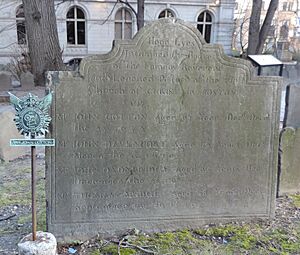John Davenport (minister) facts for kids
John Davenport (born April 9, 1597 – died May 30, 1670) was an English Puritan minister. He helped start the American colony of New Haven.
Contents
Early Life and Education
John Davenport was born in Coventry, Warwickshire, England. His family was wealthy. He went to Oxford University in 1613. He first studied at Merton College. Later, he moved to Magdalen Hall. This college was known for its Puritan ideas.
John Davenport did not finish his degree right away. He returned to Oxford in 1625. Then he earned his BD and MA degrees. His father, Henry Davenport, was a draper and mayor of Coventry. His mother was Winifred Barnaby. John also had a brother, Francis Davenport, who became a Catholic theologian.
Becoming a Minister
After college, John Davenport became a chaplain at Hilton Castle. He then worked as a curate at St Lawrence Jewry in London. In 1624, he became the vicar of St. Stephen's Church in London.
He worked with John Preston, a well-known Puritan teacher. Davenport helped publish Preston's writings after Preston died. Davenport tried to help country ministers. But his efforts were stopped by Bishop William Laud. In 1633, Davenport left the official church. He then moved to Holland.
Starting a New Colony
In 1637, John Davenport got permission to start a colony in Massachusetts. He sailed to Boston with many people from his church. In March 1638, he was in Boston. He was present during the church trial of Anne Hutchinson. This trial led to her being removed from the church.
Later that month, Davenport helped found the Colony of New Haven. He started it with his friend, Theophilus Eaton. Eaton was a rich merchant from London. He became the colony's first governor. Davenport strongly believed in education. He is often given credit for helping to start Hopkins School. He was an important leader in New Haven.
Church Beliefs and Challenges
John Davenport always supported strict Puritan rules. He believed that only children of full church members should be baptized. This idea caused problems for him in Holland. He had a disagreement with his pastor, John Paget. This led Davenport to leave the Puritan church in Amsterdam.
In New England, he strongly disagreed with the Half-Way Covenant. This was a new idea from 1662. It suggested that children of "half-way" members could be baptized. "Half-way" members were baptized as babies. But they had not yet shown they had a "conversion" experience. Davenport believed this was wrong.
Later Years in Boston
In 1667, the First Church in Boston asked Davenport to be their new pastor. Their old pastor, John Wilson, had died. Some people in the church did not want him. They did not like his strong views on baptism. Davenport needed permission from his old church to leave. The New Haven church did not want him to go.
Still, he moved to Boston in 1668. He showed a letter that seemed to let him leave New Haven. He became pastor of the First Church in December 1668. But some people who opposed him left. They formed a new church called the Third (or Old South) Church.
In May 1669, Davenport gave an important sermon. He spoke to the General Court in Boston. He criticized councils that interfered with churches. He died the next year, on March 15, 1670. He was buried in Boston.
Legacy
John Davenport had a vision for a university. This idea later became Yale University. It was founded about 30 years after his death. Davenport College at Yale is named after him. An oil painting of him is in the Yale collection. He also helped start Hopkins School, a grammar school, in 1660.



